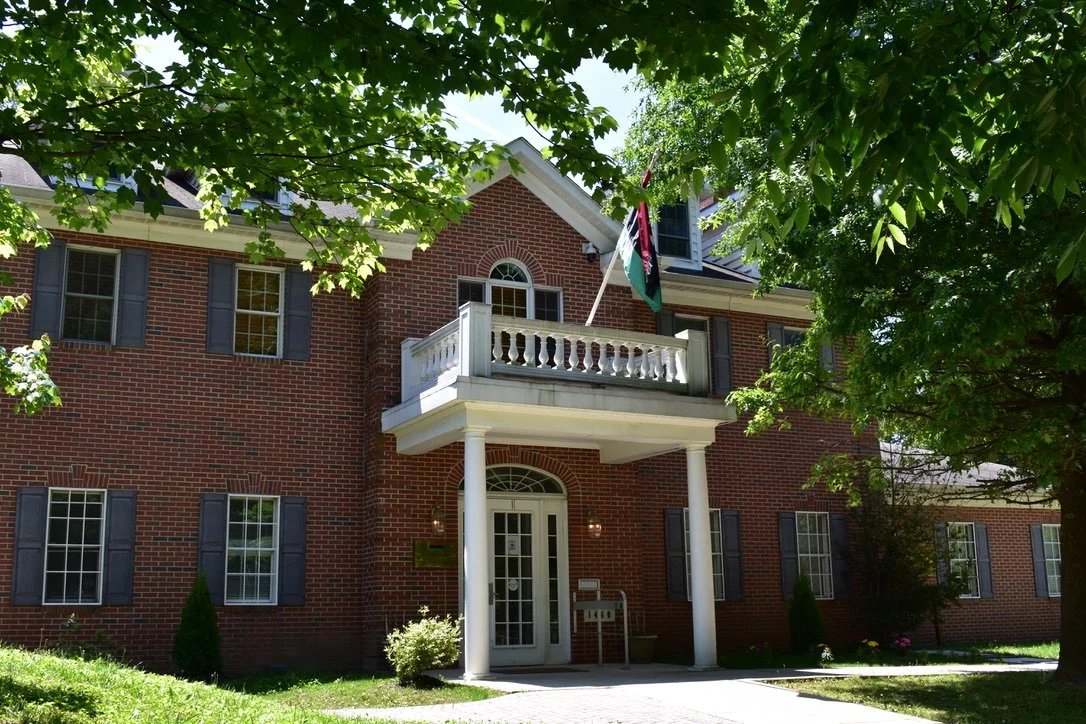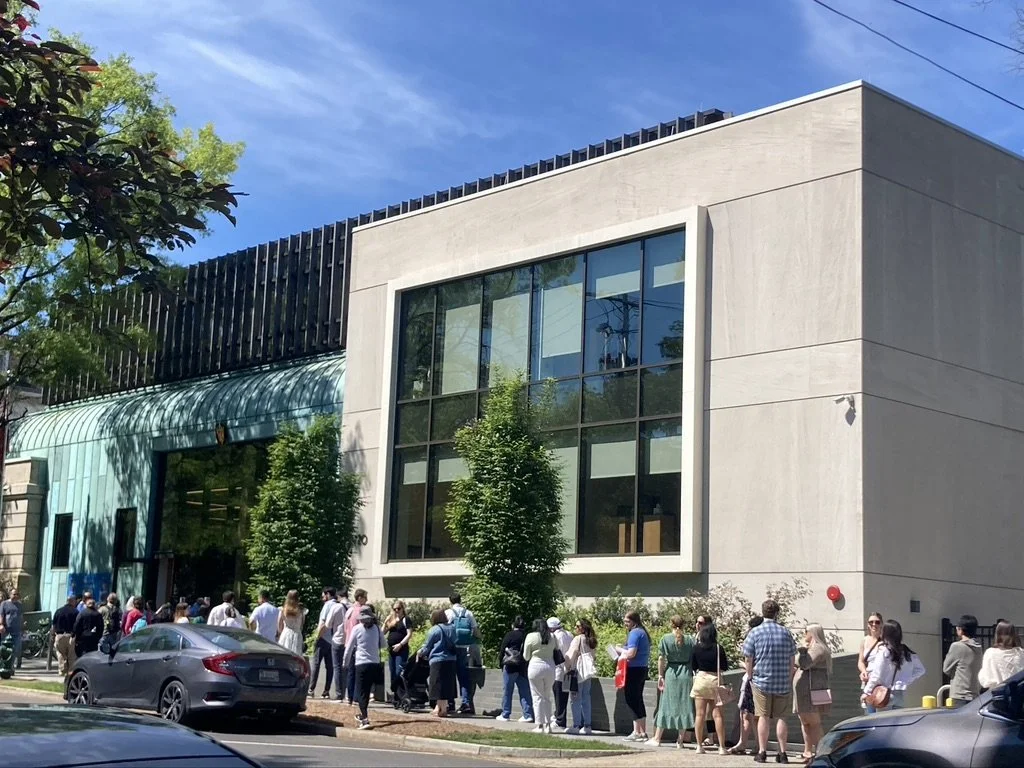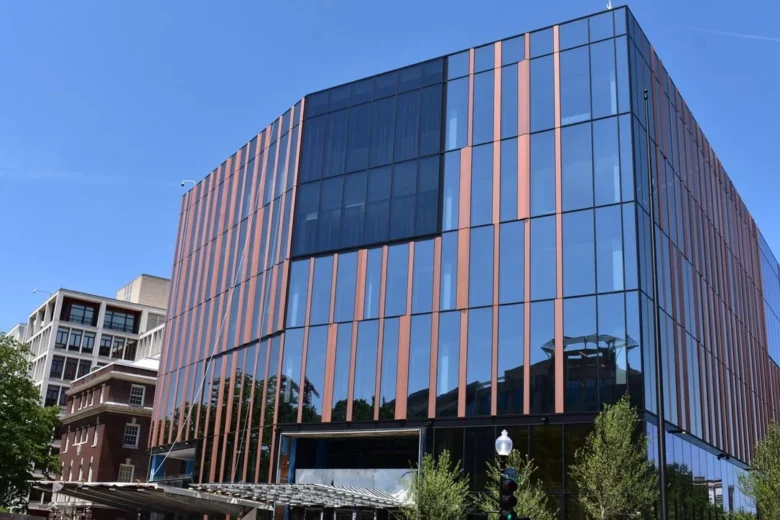Change is one of the constants of Washington, particularly when it comes to the diplomatic corps. Ambassadors and their staffs come and go, rotating in and out in a parade of fanfare, cycling through Gilded Age mansions or built-for-purpose chanceries. Some leave for their next post with a fond farewell, others are more determined to leave a mark on their country’s missions here. But while the faces and names may change, more often than not, the embassies themselves stay mostly the same.
This is partly because building renovations can often take years, and be quite a hassle, particularly when a remodel forces staff into temporary office space, or prevents entertaining or hosting heads of state or other delegations. Navigating daily diplomatic responsibilities, let alone negotiating with contractors, leasing agents, uprooted staff, and more, is often a task left for the next ambassador. And often, the one after that.
The past few years have challenged that notion, however, as embassies that were forced to shutter their doors to the public took the opportunity to reevaluate their spaces. Some moved locations altogether, others tore down existing buildings to build new from the ground up, and others overhauled their spaces entirely. Whether adding more office space, creating more expansive entertaining areas, or just making much needed repairs and upgrades, embassies and residences in Washington have seen a flurry of activity.
Take the Embassy of Morocco, which became the last embassy to move into the International Chancery Center in Van Ness, thus completing the Center’s capacity. Or the Embassy of Libya, which became the first embassy to move into the newly-designated Foreign Missions Center at the Historic Walter Reed complex, 32 acres in Northwest Washington that, as stands now, resembles more the movie set of a post-apocalyptic nature documentary than the thriving chancery center it will, in a few years, become.
But unlike many people who, when facing lockdowns at home, chose to implement some upgrades, building, moving, or renovating an embassy is a slightly more complicated matter.
“People always think that embassies have these huge security requirements and such and it varies greatly depending on the embassy,” Mark Bellingham, president of Monarch Construction, which has managed new builds and renovations on embassies throughout Washington, said. “A lot of factors come into play – certain embassies get tax exemptions, which helps on the costs Some don’t. Some get more help from the State Department, some have local political issues with zoning.”
That issue of zoning is made better or worse depending on where an embassy is located; in a residential area, like Embassy Row or Tilden Street, or in one of the designated chancery zones, like International Chancery Center or the new Foreign Missions Center?
The Foreign Missions Act, which oversees the process used to establish, accredit or terminate foreign missions, including renovations and disposals of property. Because it predates the International Chancery Center, and the Foreign Missions Center, separate agreements had to be drawn up for each.
“Definitely foreign missions in Washington are quite unique because you have a lot of foreign missions in a lot of the northwest area of DC,” says Angela Mar Dupont, a senior urban planner with the National Capital Planning Commission, which is working with the State Department to design the master plan for the Foreign Missions Center. “Because the International Chancery Center is fully built out, there is a lot of effort between State and NCPC on the master planning of that site knowing it would be primarily for foreign missions.”

The Embassy of Libya, now the sole embassy in the Foreign Missions Center, had to maintain the look of the Historic Walter Reed compound when it renovated one of the historic buildings on campus for its new embassy. The Embassy of Morocco, while still having to conform to planning and building limitations, built its embassy for purpose, and its architecture more closely resembles national architecture and design. The Embassy of Philippines, which renovated both its old chancery on Massachusetts and its main chancery across the street with varying levels of upgrades, focused primarily on ground repairs, security upgrades, and expanding space to showcase their collection of work by Filipino artists and didn’t change the look of its exteriors beyond a facelift.
For a more dramatic approach, however, one need only look to the Embassy of Australia; its prominent rebuild on Massachusetts Avenue’s Scott Circle, across from the Embassy of Tunisia’s distinct façade, has for several years been kept tightly under wraps. Utilizing Bates Smart, the embassy’s original architect from fifty years ago, the new building, when completed in the latter half of 2023 will evoke…” the spirit of Australia through direct references to its distinctive geography, with bright and clear natural light and open skies, warm materiality, and vast scale — creating a symbol of Australia that is both welcoming and enduring.” The new embassy is being built to both Green Star standards of the Green Building Council of Australia, and the U.S. Green Building Council’s Leadership in Energy and Environmental Design (LEED).
Given the scale of the renovation, the Australian embassy staff had to relocate during the construction, something to which the staff of the Norwegian embassy can relate.

Ragnar Utklev Thoresen, the facilities manager at the Norwegian Embassy, which is attached to its historic residence facing Massachusetts Avenue at Observatory Circle, explained that the staff moved into the building which houses the Liechtenstein Embassy, neighboring the House of Sweden, for two years while their renovation was underway. Moving, rather than staying and completing the renovations in phases, as the Embassy of the Netherlands is currently doing, brought its own challenges.
“Since it’s an embassy we can’t just move into regular office space, it has to be made secure for an embassy,” Thoresen said, “so it was a small renovation to make it secure mainly for safety to embassy standards.”
The renovation included not only more office space, but the removal of a one-lap swimming pool, and the creation of a large hall between the residence and the chancery, with doors that open into an expansive garden, now used for meetings and events like the country’s first participation in Around the World as part of this year’s Passport DC.
“For the material we used a lot of wood and copper,” Thoresen said. “These are all typical Norwegian materials; copper, wood and stone, granite. The Statue of Liberty is built with Norwegian copper. It was built in France but the copper is Norwegian, so we wanted to highlight that with the front of the embassy being copper and the roof copper.” Like the Australians, the Norwegians also built to LEED standard, earning the Gold designation. The Swedes also built to green building standards, as did the Dutch.
Thelma Phillip-Browne, the former ambassador to St. Kitts and Nevis, oversaw the renovation of the chancery building her country jointly owned with four other member states of the Organization of Eastern Caribbean States (OECS). When the building developed mold and other issues, four of the nation’s embassies moved into rented space in Arlington. Phillip-Browne was renting not only office space but residence space as well, having to move both when rents increased or leases were unfavorable. With the support of her fellow ambassadors, she arranged to have St. Kitts and Nevis purchase the building outright, and renovated the top floors for an ambassador’s residence. Although she dealt with supply chain and other issues related to the pandemic, she said of the renovation, “Not everyone will face the challenges we did, like the supply chain issues, but despite the headache, I would recommend anyone do it.”
While full-scale renovations can be time-consuming, inconvenient, and costly, they can also be exciting and satisfying. Thoresen at the Norwegian embassy said he’s very pleased with how the remodel turned out. Phillip-Browne, whose term ended before the renovation was complete, and won’t ever live in the building she fought so hard to secure, is proud of the presence her small island country has in Washington. Mark Lim of the Philippines Embassy points out that the country’s renovations mean they’re able to showcase and present paintings by Filipino national artists that were otherwise in storage, even prior to the renovations. The Swedes see their consolidated embassy and residence as meeting the new needs of modern diplomacy.
While renovations or moves to add offices or reconfigure meeting space is one thing, having to do a massive renovation because of a costly maintenance issue is another. One only has to look to the saga of the Embassy of Pakistan’s R Street property, or the Embassy of Sweden’s former residence in American University Park, which they sold earlier this year.
“We see so many embassies that fall into disrepair and it gets exponentially worse as time goes on,” Bellingham said. “Preventative maintenance can save you a lot of money in the long run.” He and his team offer free consultations to embassies to help ward off problems.
“Even for a non-embassy, you don’t let the building you have run down in DC because it always appreciates, so you hold onto something you have in D.C.,” Phillip-Browne said. “And it raises your profile, it makes your diaspora feel good, people come in to do business with you and your country. I would say, when it comes to fixing up your building, you go for it.”
This article originally appeared in The Washington Diplomat through a partnership with Diplomatica Global Media.
